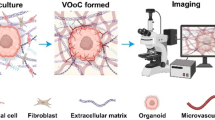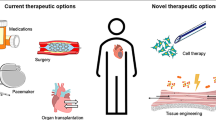Abstract
This paper presents in vitro microvascular network formation within 3D gel scaffolds made from different concentrations of type-I collagen, fibrin, or a mixture of collagen and fibrin, using a simple microfluidic platform. Initially, microvascular network formation of human umbilical vein endothelial cells was examined using live time-lapse confocal microscopy every 90 min from 3 h to 12 h after seeding within three different concentrations of collagen gel scaffolds. Among the three collagen gel concentrations, the number of skeletons was consistently the highest at 3.0 mg/mL, followed by those of collagen gel scaffolds at 2.5 mg/mL and 2.0 mg/mL. Results demonstrated that concentration of collagen gel scaffolds, which influences matrix stiffness and ligand density, may affect microvascular network formation during the early stages of vasculogenesis. In addition, the maturation of microvascular networks in monoculture under different gel compositions within gel scaffolds (2.5 mg/mL) was examined for 7 days using live confocal microscopy. It was confirmed that pure fibrin gel scaffolds are preferable to collagen gel or collagen/fibrin combinations, significantly reducing matrix retractions during maturation of microvascular networks for 7 days. Finally, early steps in the maturation process of microvascular networks for 14 days were characterized by demonstrating sequential steps of branching, expanding, remodeling, pruning, and clear delineation of lumens within fibrin gel scaffolds. Our findings demonstrate an in vitro model for generating mature microvascular networks within 3D microfluidic fibrin gel scaffolds (2.5 mg/mL), and furthermore suggest the importance of gel concentration and composition in promoting the maturation of microvascular networks.





Similar content being viewed by others
References
Allen, P., J. Melero-Martin, and J. Bischoff. Type I collagen, fibrin and PuraMatrix matrices provide permissive environments for human endothelial and mesenchymal progenitor cells to form neovascular networks. Tissue Eng. Regen. Med. 5:e74–e86, 2011.
Arganda-Carreras, I., R. Fernandez-Gonzalez, A. Munoz-Barrutia, and C. Ortiz-De-Solorzano. 3D reconstruction of histological sections: Application to mammary gland tissue. Microsc. Res. Techniq. 73:1019–1029, 2010.
Baudin, B., A. Bruneel, N. Bosselut, and M. Vaubourdolle. A protocol for isolation and culture of human umbilical vein endothelial cells. Nat. Protoc. 2:481–485, 2007.
Carmeliet, P. Angiogenesis in life, disease and medicine. Nature 438:932–936, 2005.
Carrion, B., C. P. Huang, C. M. Ghajar, S. Kachgal, E. Kniazeva, N. L. Jeon, and A. J. Putnam. Recreating the perivascular niche ex vivo using a microfluidic approach. Biotechnol. Bioeng. 107:1020–1028, 2010.
Chen, Y. C., R. Z. Lin, H. Qi, Y. Yang, H. Bae, J. M. Melero-Martin, and A. Khademhosseini. Functional human vascular network generated in photocrosslinkable gelatin methacrylate hydrogels. Adv. Funct. Mater. 22:2027–2039, 2012.
Chung, S., R. Sudo, P. J. Mack, C. R. Wan, V. Vickerman, and R. D. Kamm. Cell migration into scaffolds under co-culture conditions in a microfluidic platform. Lab Chip. 9:269–275, 2009.
Critser, P. J., S. T. Kreger, S. L. Voytik-Harbin, and M. C. Yoder. Collagen matrix physical properties modulate endothelial colony forming cell-derived vessels in vivo. Microvasc. Res. 80:23–30, 2010.
Cummings, C. L., D. Gawlitta, R. M. Nerem, and J. P. Stegemann. Properties of engineered vascular constructs made from collagen, fibrin, and collagen-fibrin mixtures. Biomaterials 25:3699–3706, 2004.
Dejana, E., and D. Vestweber. The role of VE-cadherin in vascular morphogenesis and permeability control. Prog. Mol. Biol. Transl. Sci. 116:119–144, 2013.
Discher, D. E., P. Janmey, and Y. L. Wang. Tissue cells feel and respond to the stiffness of their substrate. Science 310:1139–1143, 2005.
Drake, C. J. Embryonic and adult vasculogenesis. Birth Defects Res. C. 69:73–82, 2003.
Hsu, Y. H., M. L. Moya, P. Abiri, C. C. W. Hughes, S. C. George, and A. P. Lee. Full range physiological mass transport control in 3D tissue cultures. Lab Chip. 13:81–89, 2013.
Jain, R. K. Molecular regulation of vessel maturation. Nat. Med. 9:685–693, 2003.
Kim, C., S. Chung, L. Yuchun, M. C. Kim, J. K. Chan, H. H. Asada, and R. D. Kamm. In vitro angiogenesis assay for the study of cell-encapsulation therapy. Lab Chip. 12:2942–2950, 2012.
Kim, S., H. Lee, M. Chung, and N. L. Jeon. Engineering of functional, perfusable 3D microvascular networks on a chip. Lab Chip. 13:1489–1500, 2013.
Kniazeva, E., S. Kachgal, and A. J. Putnam. Effects of extracellular matrix density and mesenchymal stem cells on neovascularization in vivo. Tissue Eng. Part A. 17:905–914, 2011.
Koh, W., A. N. Stratman, A. Sacharidou, and G. E. Davis. In vitro three dimensional collagen matrix models of endothelial lumen formation during vasculogenesis and angiogenesis. Methods Enzymol. 443:83–101, 2008.
Kothapalli, C. R., E. van Veen, S. de Valence, S. Chung, I. K. Zervantonakis, F. B. Gertler, and R. D. Kamm. A high-throughput microfluidic assay to study neurite response to growth factor gradients. Lab Chip. 11:497–507, 2011.
Krieger, M., M. P. Scott, P. T. Matsudaira, H. F. Lodish, J. E. Darnell, L. Zipursky, C. Kaiser, and A. Berk. Molecular Cell Biology (5h ed.). New York: W. H. Freeman and CO., ISBN 0-7167-4366-3, 2004.
Lai, V. K., C. R. Frey, A. M. Kerandi, S. P. Lake, R. T. Tranquillo, and V. H. Barocas. Microstructural and mechanical differences between digested collagen-fibrin co-gels and pure collagen and fibrin gels. Acta Biomater. 8:4031–4032, 2012.
Lai, V. K., S. P. Lake, C. R. Frey, R. T. Tranquillo, and V. H. Barocas. Mechanical behavior of collagen-fibrin co-gels reflects transition from series to parallel interactions with increasing collagen content. J. Biomech. Eng. 134:011004, 2012.
Laurens, N., M. A. Engelse, C. Jungerius, C. W. Lowik, V. W. M. van Hinsbergh, and P. Koolwijk. Single and combined effects of alphavbeta3- and alpha5beta1-integrins on capillary tube formation in a human fibrinous matrix. Angiogenesis 12:275–285, 2009.
Lee, T. C., R. L. Kashyap, and C. N. Chu. Building skeleton models via 3-D medial surface axis thinning algorithms. Cvgip-Graph Model Im. 56:462–478, 1994.
Manoussaki, D., S. R. Lubkin, R. B. Vernon, and J. D. Murray. A mechanical model for the formation of vascular networks in vitro. Acta Biotheor. 44:271–282, 1996.
Merks, R. M., E. D. Perryn, A. Shirinifard, and J. A. Glazier. Contact-inhibited chemotaxis in de novo and sprouting blood-vessel growth. PLoS Comput. Biol. 4:e1000163, 2008.
Murray, J. D. On the mechanochemical theory of biological pattern formation with application to vasculogenesis. C. R. Biol. 326:239–252, 2003.
Parsa, H., R. Upadhyay, and S. K. Sia. Uncovering the behaviors of individual cells within a multicellular microvascular community. Proc. Natl. Acad. Sci. U.S.A. 108:5133–5138, 2011.
Patan, S. Vasculogenesis and angiogenesis as mechanisms of vascular network formation, growth and remodeling. J. Neurooncol. 50:1–15, 2000.
Raeber, G. P., M. P. Lutolf, and J. A. Hubbell. Molecularly engineered PEG hydrogels: a novel model system for proteolytically mediated cell migration. Biophys. J. 89:1374–1388, 2005.
Rao, R. R., A. W. Peterson, J. Ceccarelli, A. J. Putnam, and J. P. Stegemann. Matrix composition regulates three-dimensional network formation by endothelial cells and mesenchymal stem cells in collagen/fibrin materials. Angiogenesis 15:253–264, 2012.
Rowe, S. L., and J. P. Stegemann. Interpenetrating collagen-fibrin composite matrices with varying protein contents and ratios. Biomacromolecules 7:2942–2948, 2006.
Ruegg, C., and A. Mariotti. Vascular integrins: pleiotropic adhesion and signaling molecules in vascular homeostasis and angiogenesis. Cell. Mol. Life Sci. 60:1135–1157, 2003.
Selimovic, S., M. R. Dokmeci, and A. Khademhosseini. Research highlights. Lab Chip. 12:5127–5129, 2012.
Serini, G., D. Ambrosi, E. Giraudo, A. Gamba, L. Preziosi, and F. Bussolino. Modeling the early stages of vascular network assembly. EMBO J. 22:1771–1779, 2003.
Sieminski, A. L., R. P. Hebbel, and K. J. Gooch. The relative magnitudes of endothelial force generation and matrix stiffness modulate capillary morphogenesis in vitro. Exp. Cell Res. 297:574–584, 2004.
Sudo, R., S. Chung, I. K. Zervantonakis, V. Vickerman, Y. Toshimitsu, L. G. Griffith, and R. D. Kamm. Transport-mediated angiogenesis in 3D epithelial coculture. FASEB J. 23:2155–2164, 2009.
Vailhe, B., M. Lecomte, N. Wiernsperger, and L. Tranqui. The formation of tubular structures by endothelial cells is under the control of fibrinolysis and mechanical factors. Angiogenesis 2:331–344, 1998.
Vailhe, B., D. Vittet, and J. J. Feige. In vitro models of vasculogenesis and angiogenesis. Lab. Invest. 81:439–452, 2001.
van Hinsbergh, V. W., M., A. Collen, and P. Koolwijk. Role of fibrin matrix in angiogenesis. N. Y. Acad. Sci. 936:426–437, 2001.
Vernon, R. B., J. C. Angello, M. L. Iruela-Arispe, T. F. Lane, and E. H. Sage. Reorganization of basement membrane matrices by cellular traction promotes the formation of cellular networks in vitro. Lab. Invest. 66:536–547, 2003.
Vickerman, V., J. Blundo, S. Chung, and R. Kamm. Design, fabrication and implementation of a novel multi-parameter control microfluidic platform for three-dimensional cell culture and real-time imaging. Lab Chip. 8:1468–1477, 2008.
Wong, K. H., J. M. Chan, R. D. Kamm, and J. Tien. Microfluidic models of vascular functions. Annu. Rev. Bomed. Eng. 14:205–230, 2012.
Yeon, J. H., H. R. Ryu, M. Chung, Q. P. Hu, and N. L. Jeon. In vitro formation and characterization of a perfusable three-dimensional tubular capillary network in microfluidic devices. Lab Chip. 12:2815–2822, 2012.
Acknowledgments
We would like to thank Lee L. S. Ong and M. S. Chong for very useful discussions. HUVECs were kindly provided by Dr. M. S. Chong (Department of Obstetrics and Gynaecology, Yong Loo Lin School of Medicine, National University of Singapore, Singapore). We also thank Sihua Huang for her support with preparing devices and Grace S. Park for her assistance with figure preparation. This work was supported by funding from the Singapore-MIT Alliance for Research and Technology (SMART) Center.
Author information
Authors and Affiliations
Corresponding author
Additional information
Associate Editor Philip Leduc oversaw the review of this article.
Electronic supplementary material
Below is the link to the electronic supplementary material.
Rights and permissions
About this article
Cite this article
Park, Y.K., Tu, TY., Lim, S.H. et al. In Vitro Microvessel Growth and Remodeling within a Three-Dimensional Microfluidic Environment. Cel. Mol. Bioeng. 7, 15–25 (2014). https://doi.org/10.1007/s12195-013-0315-6
Received:
Accepted:
Published:
Issue Date:
DOI: https://doi.org/10.1007/s12195-013-0315-6




